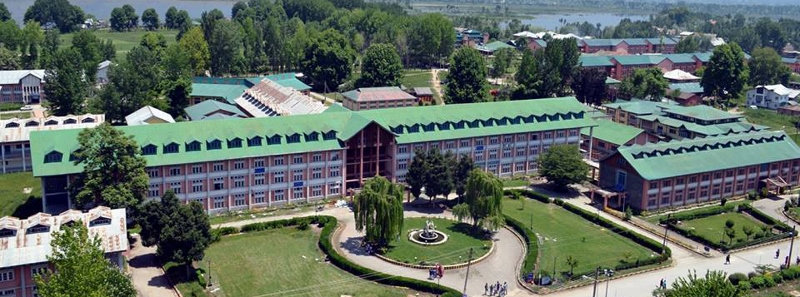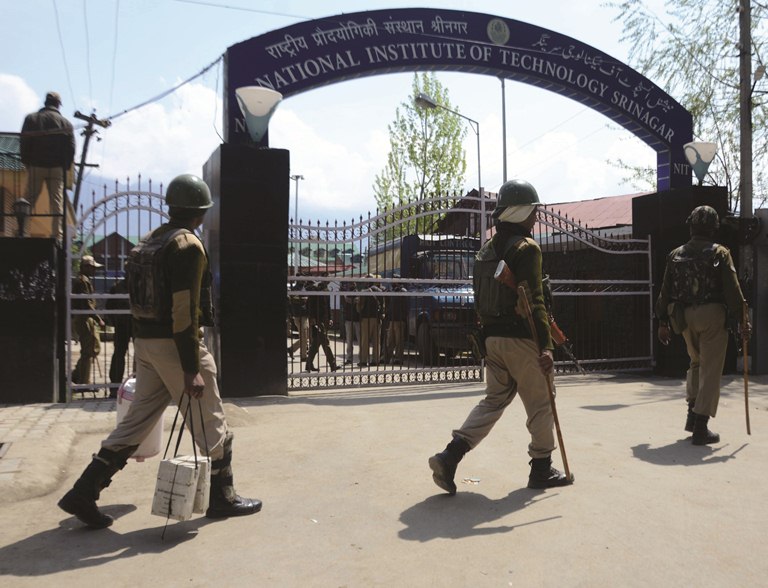When minor scuffle between two student groups gets 24×7 coverage on Television, something is not right. Mohammad Raafi reports how NIT Srinagar is turned into virtual battleground of conflicting narratives

On March 31, 2016, moments after Andrew Russel hit Virat Kohli for a six over deep mid-wicket Kashmir erupted in celebrations. The ‘six’ dashed India’s hope of making it to T-20 World Cup final, but Kashmir was altogether a different story. Braving cold weather, hundreds of youth literally jumped out of their beds to celebrate India’s loss. The otherwise quite neighbourhood of Downtown lit up with fireworks and crackers.
At the same time, at National Institute of Technology (NIT) Srinagar – where almost 80 percent students are non-Kashmiris – a small minority of Kashmiri students too cheered for West Indians. Within half an hour people were back to their routine. T-20 was history. But not for non-local students at NIT Srinagar, who went door-to-door looking for Kashmiri students, allegedly harassing them inside the campus where they enjoyed majority. Even after the verbal-duel between locals and non-locals inside the campus that night, things remained calm.
“Post match celebrations irked some non-local students who went room to room abusing Kashmiri students, male as well as female,” says Junaid, a third year student at NIT.
As tempers ran high inside the campus, non-locals began raising Bharat mata ki jai and Vande Matram slogans.
“In response, Kashmiri students raised pro-Kashmir and pro-freedom slogans,” says Junaid.
The intense sloganeering went on till late night hours making faculty members, residing inside the campus, fear for their safety.
The next morning, non-local students marched towards director Dr Rajat Gupta’s office with an intention to give him a written application seeking action against locals who celebrated India’s loss in T-20.
“We wanted to tell him (director) about the incident that had occurred the previous night,” said Rahul, a third year student. “But he did not meet us.”
Instead of talking to their classmates and sort things out, non-local students took out a march when all the local students and local faculty members were out for Friday congregational prayers.
“Once back from prayers, we were shocked to see a mob of around 500 non-local students with iron rods,” says Junaid. “They were shouting slogans, vandalizing college property including registrar’s car and some private vehicles.”
At that point some senior students, staff members and scholars tried to pacify the mob, but failed. “However, we found ourselves in the midst of a quarrel,” says Junaid.

Unaware of the drama, Imtiyaz, who works with a courier company, and used to frequently visit the campus to deliver parcels to students, reached the NIT main gate. He was stopped by the mob and asked to say: Bharat mata ki jai, which he refused to do. “They (non-locals students) then dragged him on the ground and started beating him ruthlessly,” says an eyewitness, who wishes to remain anonymous. “Some scholars and senior students tried to intervene but were pushed and abused too.”
As things turned ugly, a police party from Nigeen police station reached the spot to pacify the situation. “Despite being requested several times not to resort to violence, they assaulted a police officer,” station house officer of Nigeen police station said. “They were adamant to go out of the campus.”
The officer said they used cane-charge to control the situation and disperse the charged students. Seven students received minor injuries, however, no one was seriously injured.
The scene changed dramatically after the lathi-charge. “Sensing trouble after misbehaving with police officers, non-local students unfurled Indian flag,” claims Junaid. This, Junaid said, was aimed at diverting attention from vandalism to nationalism.
The tension prompted NIT authorities to order the closure of the campus. “It is not that every non-local student is trying to vitiate the atmosphere. These are a few students and to avoid further damage and disturbance we had to shut down the campus,” F A Mir, registrar NIT Srinagar, said.
“In view of the prevailing indiscipline created by the students from today, the Institute is closed till further orders,” read the April 1, 2016, notice. “Students are therefore asked to vacate the hostels.”
However, after intervention from the top officials and Kashmir police chief’s visit to the campus, the issue was “settled”. “Things were back to normal,” says Gyasuddin, a senior faculty member and an alumnus of NIT.
Later in the evening, in order to ease the prevailing tension, students exchanged pleasantries and invited each other to their respective hostels. “The night passed off peacefully,” says Atif, a second year student.

But instead of going back to their normal routine, some 800 non-local students assembled in the campus on Saturday, April 2, and tried to take out a march towards the main gate. “They once again went on a rampage destroying college property,” says Shafat, a third year student at NIT.
“Video and photographs showing policemen beating non-local students had gone viral. No doubt policemen carried lathis but reality is something different. They used mild force to disperse them,” says Junaid.
Later in the day, these videos and pictures found their way on Delhi-based TV channels, giving an entirely different twist to the row. “Same evening we organized a friendship event to ease the tension. However, barring a few, no non-local student turned up,” said Shafat.
A number of Delhi-based TV channels flew their special crews to cover the “crisis” and the “police brutality”. A group of students drove to Jammu for briefing the media (they remained hooded throughout) without even making a scant effort to sensitize the press in Srinagar. The skewed coverage by the electronic media has triggered serious concern within the police force that feels “belittled”.
Part of the coverage was sensational. Even one report suggested that for every two students there is one CRPF man, suggesting as if the NIT is unsafe for outsiders.
A non-local senior administrator sees a hidden hand behind Saturday’s stand off as things were sorted out on Friday itself. “I don’t understand why they assembled on Saturday again when the tension was already over the previous night.”

What happened next was surprising. Union Human Resource Development (MHRD) Minister Simriti Irani flew a three member team to NIT Srinagar to take stock of the situation.
“It felt as if there was no government in place in J&K. Situation was handled from Delhi bypassing state administration,” says Atif. “Why did Rajnath Singh personally called state police Chief?”
This triggered a larger debate in Kashmir. Prof Shafi who teaches at University of Kashmir asks why no such reaction from Delhi media when Kashmiris are attacked outside the valley? “Was this attempted at communalizing Kashmir?” asks Shafi.
“How many times MHRD has intervened when Kashmiri students are attacked outside the valley,” asked an NIT faculty member.
NIT in Hazratbal was established in 1960 as Regional Engineering College Srinagar (REC). Among the first eight REC’s established in India during first Five Year Plan, the Srinagar campus was affiliated with University of Kashmir. Before it was converted into NIT (in 2003), REC Srinagar had history of hosting students from Indian mainland and abroad. It was once popular destination for students from Palestine, Libya, Afghanistan, and Iraq.
“The atmosphere was always cordial barring a few incidents during early 90s when protests against Indian took place inside the campus,” recalls Javaid, a former student of REC. “During first Palestinian Intifada we carried a Palestinian student on our shoulders all the way to Lal Chowk, the procession included non-locals as well.”
After the conversion of REC into NIT the ratio of local and non-local students was to be maintained at 50:50. But there are only 20 percent locals enrolled right now.
“Out of 50 percent share to the state, 25 percent goes to Jammu division, while out of remaining 25 percent only 10 percent make it to the NIT,” says a local student. This has reduced Kashmiri students to a minority inside the campus.
After the MHRD team visited NIT Srinagar, non-local students put forth a set of demands including permanent deployment of CRPF for their security. “They want CRPF protection from whom? Did they forget how locals helped them during September 2014 floods and hosted them inside our homes,” asks Junaid.
An NIT alumnus Nitish Kumar wrote on his Facebook page, “Before hurling abuses and defaming the hospitality of Kashmiris, we non-local students need to be reminded of 2008 unrest. Kashmiris provided food and shelter to all of us studying at NIT Srinagar. They opened their hearts and provided free food and shelter to all of us in our hostel rooms. At that time no army or Arnab helped us. Stop undeclared war on Kashmiri students.”
Note: Some names have been changed on request.















